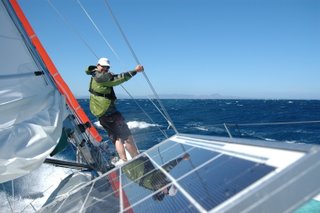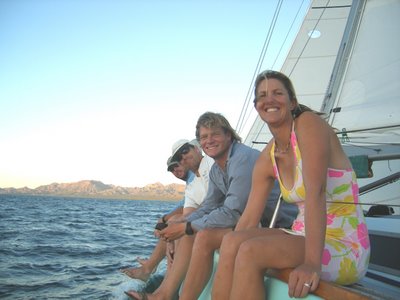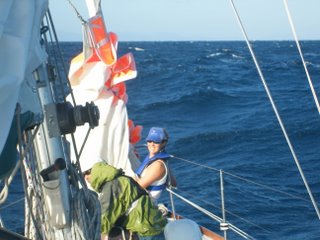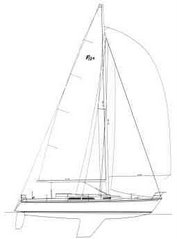Tuesday, November 07, 2006
Monday, November 06, 2006

Now that we've made it to Mexico it's time to go to work. Confetti will be staying in Coyote Bay while we teach the sailing instructor's course for NOLS. After 35 days in the field, we'll be back on December 18th and ready for the Zuiches family to join us on board for Christmas. Many thanks for all the support!
Coyote Bay
Confetti is now safely moored in Coyote Bay, in the Bay of Conception, in front of the NOLS Branch. After some exciting upwind sailing in the Sea of Cortez with double-reefed main and storm jib we sailed down Conception Bay with the spinnaker flying and grins all around, knowing that we had completed the first leg of the journey. Going forward on the deck to reef (reduce sail area) is always an exciting adventure.
Going forward on the deck to reef (reduce sail area) is always an exciting adventure.

We stopped for one night in beautiful San Basilio, where some friends of ours were anchored with a NOLS course. They brought the little Drascombe Longboat out for a visit, which made Confetti look huge!
 Going forward on the deck to reef (reduce sail area) is always an exciting adventure.
Going forward on the deck to reef (reduce sail area) is always an exciting adventure.
We stopped for one night in beautiful San Basilio, where some friends of ours were anchored with a NOLS course. They brought the little Drascombe Longboat out for a visit, which made Confetti look huge!

Systems
 Even though Confetti is a "sailboat,"there are about a million other systems on board always requiring attention. The Volvo 3cyl. 43hp diesel inboard engine is one of those. We carry 100 gallons of fuel with us, which we consume at a rate of about 1-1/4 gallons/hour. Generally we can motor at 7-knots (nautical miles per hour), so we have the capability to motor roughly 560-nm's (the trip from San Francisco was about 1600).
Even though Confetti is a "sailboat,"there are about a million other systems on board always requiring attention. The Volvo 3cyl. 43hp diesel inboard engine is one of those. We carry 100 gallons of fuel with us, which we consume at a rate of about 1-1/4 gallons/hour. Generally we can motor at 7-knots (nautical miles per hour), so we have the capability to motor roughly 560-nm's (the trip from San Francisco was about 1600).Depending on how long the passage is we will motor when the wind is light or non-existent, but the engine is also really important for charging the batteries (we have 5 car size) when the solar panels can't keep up.
The batteries run all the navigation instruments and electronic equipment, the cabin and running lights (so other vessels can see us at night), the pressure water, refrigerator, watermaker (yes we can turn salt water into FRESH!!!!! at a rate of 12 gallons/hour), fans (it is hot here!), radar, VHF radio, HF radio and of course the stereo that we have our ipod plugged into. Managing our power consumption, keeping the batteries charged and making sure all systems are working properly is a big part of each day at sea.

Subscribe to:
Posts (Atom)



